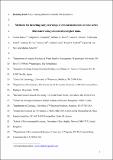| dc.contributor.author | Ellison, Aaron M. | |
| dc.contributor.author | Dakos, Vasilis | |
| dc.contributor.author | Carpenter, Stephen R. | |
| dc.contributor.author | Brock, William A. | |
| dc.contributor.author | Guttal, Vishwesha | |
| dc.contributor.author | Ives, Anthony R. | |
| dc.contributor.author | Kéfi, Sonia | |
| dc.contributor.author | Livina, Valerie | |
| dc.contributor.author | Seekell, David A. | |
| dc.contributor.author | van Nes, Egbert H. | |
| dc.contributor.author | Scheffer, Marten | |
| dc.date.accessioned | 2012-09-24T20:46:14Z | |
| dc.date.issued | 2012 | |
| dc.identifier.citation | Dakos, Vasilis, Stephen R. Carpenter, William A. Brock, Aaron M. Ellison, Vishwesha Guttal, Anthony R. Ives, Sonia Kéfi, et al. 2012. Methods for detecting early warnings of critical transitions in time series illustrated using simulated ecological data. PLoS ONE 7(7): e41010. | en_US |
| dc.identifier.issn | 1932-6203 | en_US |
| dc.identifier.uri | http://nrs.harvard.edu/urn-3:HUL.InstRepos:9637972 | |
| dc.description.abstract | Many dynamical systems, including lakes, organisms, ocean circulation patterns, or financial markets, are now thought to have tipping points where critical transitions to a contrasting state can happen. Because critical transitions can occur unexpectedly and are difficult to manage, there is a need for methods that can be used to identify when a critical transition is approaching. Recent theory shows that we can identify the proximity of a system to a critical transition using a variety of so-called ‘early warning signals’, and successful empirical examples suggest a potential for practical applicability. However, while the range of proposed methods for predicting critical is rapidly expanding, opinions on their practical use differ widely, and there is no comparative study that tests the limitations of the different methods to identify approaching critical transitions using time-series data. Here, we summarize a range of currently available early warning methods and apply them to two simulated time series that are typical of systems undergoing a critical transition. In addition to a methodological guide, our work offers a practical toolbox that may be used in a wide range of fields to help detect early warning signals of critical transitions in time series data. | en_US |
| dc.description.sponsorship | Organismic and Evolutionary Biology | en_US |
| dc.language.iso | en_US | en_US |
| dc.publisher | Public Library of Science | en_US |
| dc.relation.isversionof | doi:10.1371/journal.pone.0041010 | en_US |
| dash.license | LAA | |
| dc.subject | leading indicator | en_US |
| dc.subject | resilience | en_US |
| dc.subject | critical transition | en_US |
| dc.subject | catastrophic shift | en_US |
| dc.subject | regime shift | en_US |
| dc.subject | 47 alternative states | en_US |
| dc.subject | autocorrelation | en_US |
| dc.subject | variance | en_US |
| dc.subject | skewness | en_US |
| dc.subject | kurtosis | en_US |
| dc.subject | spectral reddening | en_US |
| dc.subject | detrended 48 fluctuation analysis | en_US |
| dc.subject | conditional heteroskedasticity | en_US |
| dc.subject | time-varying autoregressive models | en_US |
| dc.subject | BDS test | en_US |
| dc.subject | potential analysis | en_US |
| dc.subject | 50 time-series analysis | en_US |
| dc.subject | nonlinearity | en_US |
| dc.title | Methods For Detecting Early Warnings Of Critical Transitions In Time Series Illustrated Using Simulated Ecological Data | en_US |
| dc.type | Journal Article | en_US |
| dc.description.version | Accepted Manuscript | en_US |
| dc.relation.journal | PLoS ONE | en_US |
| dash.depositing.author | Ellison, Aaron M. | |
| dc.date.available | 2012-09-24T20:46:14Z | |
| dc.identifier.doi | 10.1371/journal.pone.0041010 | * |
| dash.authorsordered | false | |
| dash.contributor.affiliated | Ellison, Aaron | |


